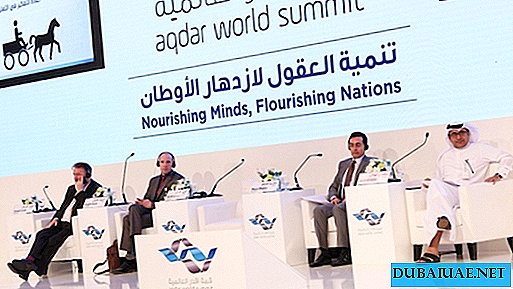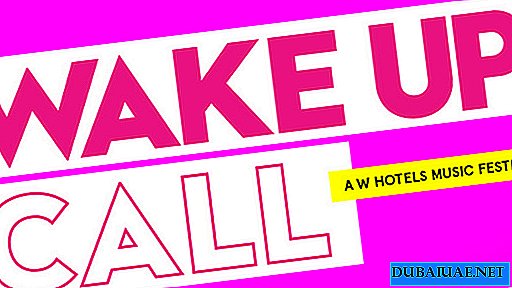JUNE 1, 2007 BECAME FOR THE UNITED ARAB EMIRATES AND FOR THE PERSIAN BAY REGION DATE HISTORICAL. THE FIRST TOLL IN THE REGION APPEARED IN DUBAI. FOR OTHERWISE, IT'S ALREADY EXISTING FOR OVER 30 YEARS, AND I HAVE MAKED A PAID GOOD PIECE OF IT BY THE DECISION OF LOCAL MANAGEMENT.
It's All about Traffic
 The city of Dubai, the main settlement of the UAE of the same name, has two troubles - traffic jams and endlessly rising prices. Fools simply cannot survive here, and the roads are magnificent, wide and numerous. It happened historically: Arabs love good powerful cars, love speed and build roads for which it is not a shame. Despite the abundance of lanes, the notoriety of Dubai traffic jams thunders throughout the region. Although, by Moscow standards, they are nothing more than babble, in the context of the Emirates, the congestion of Dubai seems simply disastrous. Out of respect for the local leadership, it must be said that it is actively and effectively addressing the problem: tens of millions of dollars are allocated from the local budget every year to improve road conditions, new roads and bridges appear, existing routes are expanding and modernizing.
The city of Dubai, the main settlement of the UAE of the same name, has two troubles - traffic jams and endlessly rising prices. Fools simply cannot survive here, and the roads are magnificent, wide and numerous. It happened historically: Arabs love good powerful cars, love speed and build roads for which it is not a shame. Despite the abundance of lanes, the notoriety of Dubai traffic jams thunders throughout the region. Although, by Moscow standards, they are nothing more than babble, in the context of the Emirates, the congestion of Dubai seems simply disastrous. Out of respect for the local leadership, it must be said that it is actively and effectively addressing the problem: tens of millions of dollars are allocated from the local budget every year to improve road conditions, new roads and bridges appear, existing routes are expanding and modernizing.
But the problem with traffic jams is not only not disappearing, but everything is getting worse day by day. The reason is simple: the share of public transport in the overall picture is less than 7%. In other words, everyone in Dubai moves in private cars, an alternative to which, buses, are right there in traffic jams. The growth in the number of registered vehicles in recent years has amounted to a phenomenal 541%, which significantly exceeds the performance of the largest megacities in the world - New York, Tokyo and London.
ONE TIME DRIVING, TWO TIMES PAYING
Dubai's central transportation artery - Sheikh Zayed Highway, named after the founding father and first president of the UAE, is the Emirates' busiest route. It stretched across almost the entire small city, linking 55 kilometers of its largest areas with the neighboring emirate of Abu Dhabi. Al-Gharhud bridge adjoins it, thrown over the Dubai bay dividing the city into two parts.
 It is here that the most important traffic jam of Dubai, sometimes reaching tens of kilometers, is built daily. The reason is that this particular section of the Dubai roads connects the residential areas of Dubai with business, and it is used by the bulk of people living in the neighboring emirate of Sharjah and working in Dubai. Cars here in the mornings and evenings move at a speed no faster than 20 km / h, despite the fact that there is not a single traffic light on the highway. According to a study by the Dubai Roads and Transport Committee (RTA), about 130,000 cars go through Sheikh Zayed Highway every day, and at least 8,000 vehicles cross Al Gharhud Bridge during rush hour.
It is here that the most important traffic jam of Dubai, sometimes reaching tens of kilometers, is built daily. The reason is that this particular section of the Dubai roads connects the residential areas of Dubai with business, and it is used by the bulk of people living in the neighboring emirate of Sharjah and working in Dubai. Cars here in the mornings and evenings move at a speed no faster than 20 km / h, despite the fact that there is not a single traffic light on the highway. According to a study by the Dubai Roads and Transport Committee (RTA), about 130,000 cars go through Sheikh Zayed Highway every day, and at least 8,000 vehicles cross Al Gharhud Bridge during rush hour.
From July 1, you must pay for using part of the Sheikh Zayed Highway and Al-Garhud Bridge. So simply and categorically, local officials decided to rid Dubai of the longest city traffic jam, blocking its traditional beginning and end with electronic “frames” that charge bribes from those who want to quickly reach their destination. It turns out that on the almost 35-kilometer stretch of the direct road, there are two payment points and you have to pay twice.
RTA executives unanimously argue that the introduction of payment by 25% should reduce the density of traffic along this segment of the path. "We are trying to solve the problem of traffic jams by introducing payment for the use of the most stressful areas, and we consider this approach effective," says Maita Obaid Bin Uday, Director General of the Transport Agency at RTA. According to foreign experts, the RTA project is fully consistent with international standards. So far, the introduction of fees for the use of other routes is out of the question.
Dear but JUST "SALIK"
 A new toll system for the city is called Salik, which in Arabic means “clean” or “open”. Only state-owned vehicles are spared the need to pay. Everyone else, including taxi passengers, will have to pay for the pleasure of moving forward. Special electronic “frames” “Salik” are already installed over the roadway at two points. They work on the principle of scanning barcodes at the checkout in the supermarket: when traveling under the “frame”, the scanner makes contact with the special “smart” sticker “Salik” on the windshield of the car and automatically removes the set amount. A little more than $ 1 per car will be charged around the clock for entering a paid leg of the journey in both directions. With a maximum of one car per day they can withdraw $ 6, which with 22 working days a month (264 days a year, respectively) will annually empty the motorist’s budget by $ 1760. It is important that you need to pay only when driving under the "frame", respectively, when entering the toll road and leaving it in other sections, the motorist should not be a penny. At least for now.
A new toll system for the city is called Salik, which in Arabic means “clean” or “open”. Only state-owned vehicles are spared the need to pay. Everyone else, including taxi passengers, will have to pay for the pleasure of moving forward. Special electronic “frames” “Salik” are already installed over the roadway at two points. They work on the principle of scanning barcodes at the checkout in the supermarket: when traveling under the “frame”, the scanner makes contact with the special “smart” sticker “Salik” on the windshield of the car and automatically removes the set amount. A little more than $ 1 per car will be charged around the clock for entering a paid leg of the journey in both directions. With a maximum of one car per day they can withdraw $ 6, which with 22 working days a month (264 days a year, respectively) will annually empty the motorist’s budget by $ 1760. It is important that you need to pay only when driving under the "frame", respectively, when entering the toll road and leaving it in other sections, the motorist should not be a penny. At least for now.
Money and others like him
The $ 28 Salik Starter Pack can be purchased at Dubai gas stations, banks, and over the Internet. It contains a sticker with a chip, which must be installed on the windshield of the car, as well as a booklet detailing the new system for Dubai. Before buying a package, each motorist must register, providing information about himself and identification documents. After registration, a balance of $ 28 is credited to his account. When activated, the annual fee of $ 14 for service will be removed from the account at a time. The remaining $ 14 can be spent when using a paid site. The service department is going to warn drivers about the need to replenish the balance through SMS messages. You can check the balance yourself by calling the free service number. Replenishment of the account is possible through prepaid cards or payment by credit card via the Internet.
Fines and obstacles
For travel under the "frame" "Salik" without an affordable loan a fine of $ 14 is provided. For travel under a frame without a sticker, they will be fined $ 28 for the first time, $ 56 for the second, and $ 112 for the third. All fines will be registered automatically by the "frame" when the violator passes under it. Motorists caught trying repeatedly to trick the smart Salik system will have to pay a $ 3,000 fine. Interestingly, scanners that read information from a sticker will not be able to recognize it if the windshield is tinted. Therefore, the RTA turned to motorists with a strong recommendation to remove part of the tint, otherwise a fine cannot be avoided, even if the Salik sticker is available.
There are alternatives, but not equivalent
 |  |
Those wishing to avoid unnecessary expenses RTA suggests using alternative routes, of which there are quite a lot. Before entering the paid section, warning signs will be installed. Motorists who do not want to pay special information boards will be sent to alternative routes: bypass roads, bridges and a tunnel through Dubai Bay. But the alternatives are not equivalent. As mentioned above, the toll section of Dubai's roads connects the residential areas of Dubai and the neighboring emirate of Sharjah, with business centers and the capital of the Emirates of Abu Dhabi. Residents of the three emirates use it daily on the way to work and back.
Paid section is the only long route in the city, on which you can move non-stop. Moreover, it has at least five lanes in each direction, even on the narrowest section. Nevertheless, alternative routes are generously decorated with traffic lights and complex intersections, which invariably slow down the movement process. Not surprisingly, motorists prefer the Sheikh Zayed Highway Linkage, Al-Gharhud Bridge, to even more convenient and wide new alternative routes.
It is worth noting that on a good stretch of the toll road, an alternative would be the roads of the most expensive local Jumeirah region, densely studded with villas, radars and speed bumps, not adapted for mass traffic. On the other hand, you can use the emirates road, which was created for heavy vehicles and car drivers often feel uncomfortable here. Soon it will be expanded to 12 lanes instead of the existing six.
As for the alternative to AlGarhud bridge, there are several of them: the old AlMaktum bridge, the Al-Shindaga underground tunnel and the new, just open complex of bridges and transport interchanges business bay. Under construction is the future largest bridge - the new Al-Garhud, and a temporary, pontoon. Thus, by the end of 2007, the total number of lanes for crossing the Dubai Bay will be 38 units, and in 2008 - 45 units in connection with the opening of the new Al-Garhud bridge. Only the old AlGarhud bridge will be paid. Nevertheless, it is he who leads to a non-stop path of 55 km.
Payment of roads - "For" and "Against"
According to the most conservative estimates, the introduction of payment for part of the Sheikh Zayed Highway - Al-Gharhud Bridge highway will bring the Dubai administration nearly $ 170 million a year, which they promise to spend on further improving the Dubai road system. Dubai motorists in their attitude to the new system of payment for the use of roads diverge. Some see this as getting rid of the need to stand in traffic jams for many hours, others are upset about the serious costs and reasonably predict an increase in traffic density on alternative routes. Of particular discontent is the fact that the payment is valid around the clock, because from late evening until early morning on weekdays and most of the days on weekends, there are no traffic jams on the highway, and you can drive it from one “frame” to another in fifteen minutes at a speed 120 km / h
Motorists also reproach the authorities with the fact that it was necessary to introduce a fee for the use of roads only after the metro was launched, which is expected at the end of 2009. But the leadership of Dubai is not going to cancel its decision, and it is somehow not accepted to swear with the authorities in the Emirates. At a recent press conference in the Committee on Roads and Transport, journalists were informed that, according to experts, high growth rates in the number of vehicles will continue, which will lead to an exceptional density of traffic on the roads. The traffic density in the morning will increase four times in the coming years. By 2020, at least 1.5 million trips will be made on the roads of Dubai every day, which seems incredible compared to the current 350 thousand today.
In order to avoid a catastrophic situation on the roads of Dubai, the main focus in the next five years will be on the development of public transport (bus, water and tram services) and the expansion of transport infrastructure. The officials expect good results both from the work of the subway now standing and from the introduction of tolls. Together, the measures taken should save Dubai from serious traffic jams. Well, wait and see, but for now we’ll have to open another item of expenditure - on Salik.











